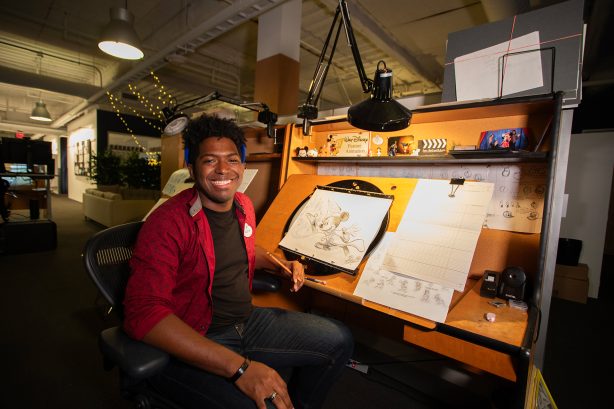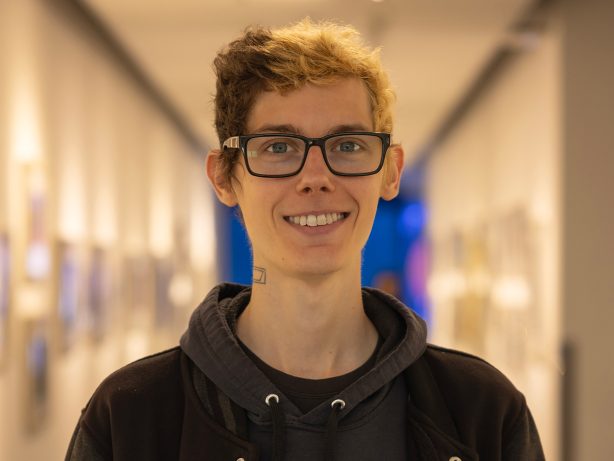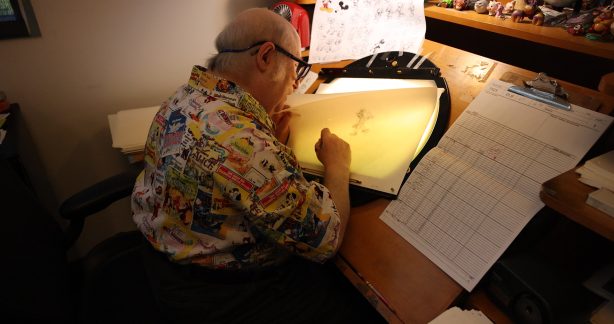Walt Disney Animation Studios’ Once Upon a Studio is a tribute to the generations of fans who have loved the studio’s 100 years of characters and stories. Written and directed by Dan Abraham and Trent Correy, the short film finds a century’s worth of characters assembling for a group portrait. All of the animation in the short is new, and approximately 80 percent of the characters in the film are hand-drawn, with award-winning animator and director Eric Goldberg serving as the head of hand-drawn animation.
The hand-drawn animation team included revered veterans such as Randy Haycock, Mark Henn, Bert Klein, and Alex Kuperschmidt, among others. Five of Disney Animation’s most accomplished alumni—Ruben Aquino, Tony Bancroft, James Baxter, Will Finn, and Nik Ranieri—also did guest assignments for classic characters. In addition, a group of hand-drawn animation apprentices—chosen from over 2,000 applicants, representing the first new hand-drawn animator hires at Disney in over a decade—started as trainees in March 2022. After a four-month training program, the novices—Robert Cox, Courtney DiPaola, Ella Louise Khan, Tyler Pacana, and Austin Traylor—made their first major mark on the Studio.
“At Walt Disney Animation Studios, we truly consider it a privilege to be at the studio that started it all,” says Clark Spencer, President of Disney Animation. “And while daunting to think about how to celebrate 100 years of storytelling, Dan and Trent’s short, as well as our incredible upcoming feature film, Wish, celebrate this moment in time in such complimentary ways—by celebrating our legacy, our present, and our future.”
Who better to represent the future than the apprentices? And who better to teach them than the very people who first inspired them to become animators? Below, Goldberg, Pacana, and Traylor share their experiences of being part of the Once Upon a Studio magic.
Tyler and Austin, what inspired you to apply for a hand-drawn apprenticeship?
Austin Traylor: The first animated film I saw was The Lion King. At a certain point, after rewinding the VHS tape, I noticed there were behind-the-scenes features—and that’s when I learned that these characters were drawings! My mind was blown. I thought, ‘I’d love to do something like that.’ Years later, I studied animation, and I also worked in the theme parks for seven years. Through that process, I learned about the history of Disney and its characters, and just how important they are to people. That’s what inspired me to apply. This apprenticeship was like my final goal—really diving into the Disney legacy and story.
Tyler Pacana: The fact that this training program was being offered was mind-blowing. It seemed like a once in a lifetime opportunity, and I’d be kicking myself if I didn’t at least try. I was lucky enough to get in and to join all the other apprentices. We worked on one of the coolest projects I’ve ever encountered as a result.
How was it decided that the apprentices would contribute to Once Upon a Studio?
Eric Goldberg: When the apprentices came in, we decided to do their exercises on classic Disney characters—knowing full well in the back of our minds that Once Upon a Studio was looming! It was great training for them to be on this project. For example, Courtney animated a test with Merlin, and it was so good that I said, ‘Let’s have her do Merlin in the film!’ She did a fantastic job! Merlin feels like he came right out of The Sword and the Stone.
Traylor: During our training days, we were allowed to pick certain characters. Through our exercises, Eric picked up on our strengths and he noticed the characters we loved. During the production process, he would issue themes with most of the characters we were already comfortable working with, that really played off of our strengths. Tyler is amazing with moving camera shots and very technical, skillful animation; I just love his work. Ella was really great with the animal characters, and Courtney was amazing with the [Disney Legend] Milt Kahl-style characters like Merlin. It really helped us all shine and solidify us.
Pacana: Austin is also not mentioning himself as [Disney Legend] Fred Moore reincarnated! He very quickly became one of the go-to guys for Mickey and Minnie in the short, including in the first scene where they pop out of the picture frame. That was Austin.

Tyler, when you heard the apprentices were being given the opportunity to animate characters for this ambitious and expansive short film, what was your initial reaction?
Pacana: I tried not to think about it too hard, because if you do, it gets really daunting. Having the supervision and the support throughout the whole project made it a lot easier. Trent and Dan are amazing directors, and they’re very personable; you never feel nervous showing them work or getting feedback from them. And of course, it helped having Eric as our supervisor and getting advice from our other mentors, like Mark, Randy, and Bert, who are very experienced with this stuff. With them around, it was never as scary as you’d think.
Goldberg: Everybody really did a fantastic job. And one of the things that’s tough when you’re working on a short like this, is that normally when you’re working on a feature, you have ramp-up time; you’ve never drawn these characters before and you’ve never animated these characters before, so there’s a little bit of time for you to get comfortable. With a short film like this, where there are so many characters and the deadline is pretty tight, it would be like, “OK, you’re doing Gurgi. Bye!” And everybody had to hit the ground running.

What are some of the Once Upon a Studio characters the apprentices animated?
Pacana: I feel really lucky, because one of my favorite Disney films is Robin Hood, and I got to do the core scene where Robin Hood comes out of the picture and grabs Scrooge McDuck’s money. I also got to do this really fun tracking shot with Elliott from Pete’s Dragon and Cody from The Rescuers Down Under. That was a great way to explore films I wasn’t as familiar with and get into those characters. And then some characters were just simply really fun to draw, like Sebastian from The Little Mermaid and Cri-Kee from Mulan.
Goldberg: To the apprentices’ credit, we didn’t have to hold their hands. They did all the legwork by going back to the original films, pulling models, and basically making sure that their drawings and their animation felt just like the originals. They really did a bang up job.
What was the best advice the animators imparted during your apprenticeship?
Traylor: “Show early. Show often.” That’s something they instilled in us from the very beginning. If they can give us their input as soon as possible, it sets us up for success. That was the main goal. And everyone was so gracious with their time. You could go up to any one of them at any time and they would be willing to help you out with anything. I’m a perfectionist, but Eric was always very patient and willing to share his knowledge with me.
Goldberg: It’s great that so many young people want to continue doing this. We were lucky enough to be mentored by some of our heroes, and hopefully, we can pay it forward to younger people coming in the Studio who want to learn this stuff and really perfect it. It’s a great feeling when you see them succeed, when you see them doing such a great job on these characters that they have never drawn or animated before. It’s really heartwarming.

What surprised you most during your apprenticeship?
Pacana: I was surprised at just how involved the pipeline is! We worked really closely with Brandon Bloch, who carried this film. He was the head of scene planning; every single shot went through his hands to make sure that it was coherent and how the directors envisioned it. He was great to turn to when we were confused about how to make things work better for the artists downstream. That was really invaluable for navigating a technically complex short as were acclimating to the Disney Animation pipeline altogether. Having that hands-on experience made it more comfortable whenever we’d dive into things as green apprentices.
Tyler and Austin, you’re both full-time animators at Disney Animation now. How did your experiences as apprentices working on Once Upon a Studio set you up for success?
Traylor: It’s crazy. I feel like I’m still learning, you know? And that’s what’s so wonderful about this place. There’s so much camaraderie. Even with us being full-time animators, our mentors’ doors are still open. We can still go and seek mentorship. For example, we still do weekly masterclasses with Randy on animation and acting. I’m still on a journey to be the best that I can be, and I’m just so happy that I’m with people who are going to support me.
Pacana: Once Upon a Studio was really great, because when you’re there from the beginning to the end, you do impromptu networking. We met people from Effects, from the CG team, from Lighting; we were even around when they were doing Stereo stuff. It ran the gamut of the Studio, and it allowed us to meet so many different people. It was great that Once Upon a Studio had that reach. We know a lot more people around us, we know what they do, and we appreciate all that goes into the things we don’t necessarily touch directly.
What do you want people to know about the hand-drawn apprenticeship program?
Traylor: It brings to light that hand-drawn animation is still being done at the Studio, because many people outside of these walls are unaware of that. It’s really inspiring to go online and see people chatting about Once Upon a Studio, saying, “Maybe someday I could pursue traditional hand-drawn animation at Disney.” That’s really exciting, and it was nice to see the rest of the world get excited that Disney continues to embrace classic animation.
Pacana: My hope is that Once Upon a Studio will garner more excitement for hand-drawn and mixed medium pieces. This is a really cool example of what can be done, and it’s something that’s maybe more ambitious than people might think we could do. I hope that Once Upon a Studio leads to more projects like it and it becomes a self-perpetuating thing.